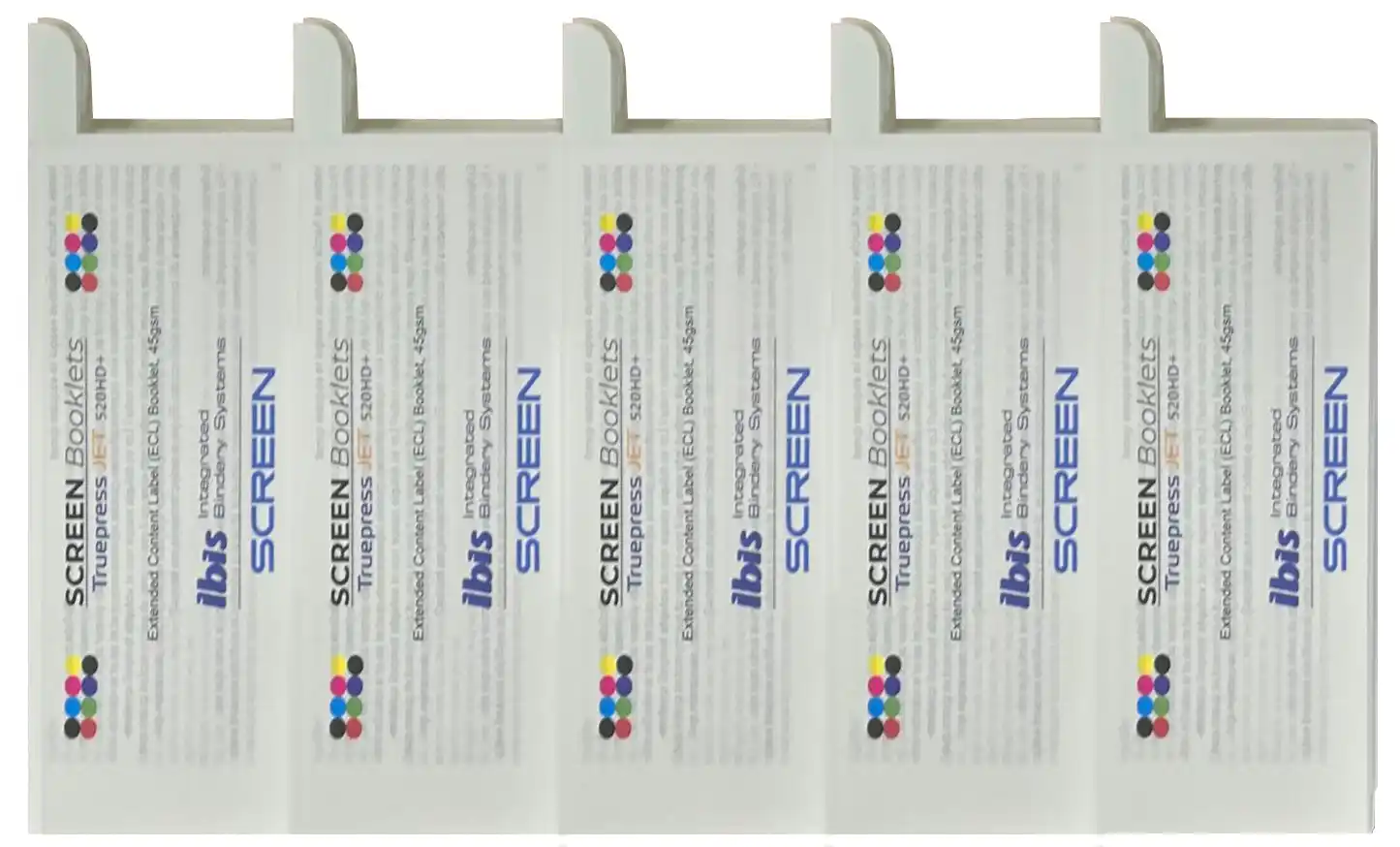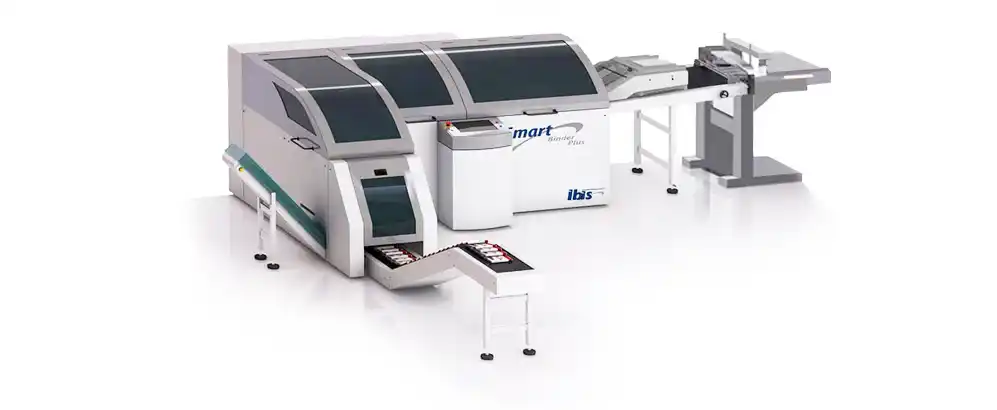Integrated
Bindery Systems
Producing Extended Content Label (ECL) booklets
Using the IBIS Smart Label-binder

The IBIS Smart-binder presents an ideal way to produce 'Extended Content Label' booklets from digital printed sheets. These ECLs are perfectly suited to provide high-quality instruction booklets for use with Pharmaceutical and Agro Chem packaging due to high quality cold-glue spine binding, very lightweight paper stock and 100% page integrity.
An in-line laser 'tabbing' system is also available to connect to the Smart-binder delivery conveyor. This automatically opens up the front cover, laser-cuts the front edge of the cover to create extended 'tabs' and cuts all the other pages to a shorter width so that only the 'tabs' remain extending on the front edge of the booklet. See item 5 (ECLs with tabs) below. Please contact IBISfor further details.

ECL labels booklets with extended tabs
IBIS Smart Label-binder at HID and LabelExpo 2025
IBIS exhibited the new Smart Label-binder at Hunkeler InnovationDays 2025 in Lucerne in February, producing ECL booklets (see image above). We will also present the Smart Label-binder producing ECL booklets on IBIS stand 3A60 at LabelExpo in Barcelona, Sept 16-19 2025.
More information about IBIS at HID25
Videos:
Producing ECL label booklets at HID 25 Producing 75mm wide ECL labels
Examples of ECL production lines
Near-line ECL booklets production (fed from a roll-unwinder & web-cutter)

Off-line ECL booklets production (fed from a sheet pile feeder, SB-095 or SB-097)

In-line Laser Tabbing system
An in-line laser 'tabbing' system is available to connect to the IBIS Smart-binder delivery conveyor. This automatically opens up the front cover, laser-cuts the front edge of the cover to create the required extended 'tabs' and cuts all the other pages to a shorter width so that only the 'tabs' remain extending on the front edge of the booklet. See item 5 below. Please contact IBIS for details.
The reason IBIS Smart-binders are used for ECL production
1. ISG cold glue binding
IBIS offer the Smart-binder with our unique and patented option ISG‑cold glue system
Cold-glue binding is essential for many ECLs, for example in the pharmaceutical labels. The use of conventional wire stitching is not an option for these label booklets.
The ISG cold-glue system is easier to use and maintain compared to wire stitch heads.
2. Lightweight paper stock
Most ECL label booklets must be produced using very lightweight paper stock in order to contain as much printed data as possible with the minimum number of pages.
The Smart-binder is unique in being able to handle paper sock weights as light at 38 gsm (25 lbs text).
3. Label Integrity
Each label must contain the correct data relating to the product to which it is attached. Each type of ECL label (for a specific product) may have an individual ID number in the printed bar code (or 2D Datamatrix code) on each sheet.
The Smart-binder reads these sheet codes and uses its sophisticated integrated sheet and booklet tracking system and sensors to monitor the status of each Label booklet and automatically reject any ‘bad’ booklets. The Smart-binder control PC retains log files containing production data relating to each booklet produced, or rejected. The production log files may be viewed externally with a network connection if required. If any booklets are missing on the delivery then these must be reprinted. The optional Smart‑data Analysis System SDA-100 assists with the upstream interface to enable this automatic reprinting of any missing Labels.
4. Small Format Sizes
Many ECL labels have a small format size because of the small dimensions of the product to which they are subsequently attached. For this reason the Smart-binder can be supplied with special modifications to reduce the minimum booklet width to 75mm (measured from the spine to the front edge).
Video of the Smart-binder producing75mm wide ECL labels
Very short spine lengths can be achieved very efficiently by printing multiple booklets together (multi-up). For example, six ECLs with a 2" spine length may be printed on a 12" long sheet. The resulting 12" long booklet is then split into the 6 individual booklets after exiting the Smart-binder. Note that booklets with spine lengths between 95 and 160mm may be produced 2-up without needing any further trimming, by using the optional Smart-binder Trimmer‑Center Knife
The additional Book Splitter Trimmer TP-100 may be added to the Smart-binder delivery to cut long booklets into multiple short booklets of any required length.
5. ECLs with tabs
Some ECLs require an extended 'tabs' on the front cover as shown below:

These extended tabs may be produced by connecting an in-line laser tabbing machine to the Smart-binder booklet delivery. This automatically opens up the front cover, laser-cuts the front edge of the cover to create the required extended ‘tabs’ and cuts all the other pages to a shorter width so that only the ‘tabs ‘ remain extending on the front edge of the booklet. Refer to IBIS for more details about this optional additional in-line tabbing system.
Alternatively, a pre-tabbed cover may be fed from the optional Smart-binder Cover Feeder providing that the stock weight is not too low. See video ECL booklets with a tab on front cover
Alternatively the additional Rosas tabbing machine may be added to the Smart-binder delivery to reduce the booklet width and cut tabs into the outside cover on one side.
6. High Reliability with Minimum Maintenance
Machine 'availability' (up-time) is of course important for all ECL label production. The Smart-binder is a very heavy-duty system designed to operate 24/7 with the minimum of maintenance and with the highest possibility reliability.
7. Ability to Change the Number of Pages on-the-Run
Some ECLs may need to be produced in very small job quantities. The Smart-binder allows the number of pages in the ECL to change between one job and the next without stopping, under bar-code control.

delivery (to optional
BSS stacker)
IBIS Smart-binder 'Plus HS'
Case Studies
Each of the following customers use the IBIS Smart-binder exclusively to produce ECL booklets:
Case study 1: Company XYZ
(name withheld for confidentiality reasons)
This company has purchased IBIS Smart-binders to produce ECL booklets at multiple locations around the world, fed both off-line from a sheet feeder and also near line from a roll unwinder and web cutter. These Smart-binders include in-line laser tabbing.
Case study 2: Codex Hungery
Codex purchased an off-line Smart-binder system with ISG cold-gluing in 2020.
Janos Toth, Production Manager, comments:
![]() Our new IBIS Smart-binder SB-3 was installed here at Codex just outside Budapest in the spring of 2020. The machine processes our digitally-printed sheets using its integral high-pile sheet feeder and we are pleased with the SB-3 performance and robust design.
Our new IBIS Smart-binder SB-3 was installed here at Codex just outside Budapest in the spring of 2020. The machine processes our digitally-printed sheets using its integral high-pile sheet feeder and we are pleased with the SB-3 performance and robust design.
The SB-3’s ability to produce large volumes of high value, high quality pharmaceutical booklets, instruction manuals and label booklets at high speeds is critical to our business. The SB-3’s patented ISG cold-glue binding process gives good bind strength and booklet lay-flat, so is popular with our label customers. ![]()
Case study 3: Company ABC in Dublin, Ireland
(name withheld for confidentiality reasons)
In 2025 this company purchased the new model Smart Label-binder together with in-line laser tabbing to produce ECL label booklets at their site in Dublin.


